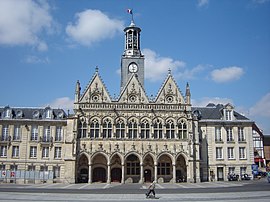Saint-Quentin, Aisne
| Saint-Quentin | ||
|---|---|---|

Town hall
|
||
|
||
| Coordinates: 49°50′55″N 3°17′11″E / 49.8486°N 3.2864°ECoordinates: 49°50′55″N 3°17′11″E / 49.8486°N 3.2864°E | ||
| Country | France | |
| Region | Hauts-de-France | |
| Department | Aisne | |
| Arrondissement | Saint-Quentin | |
| Intercommunality | Saint-Quentin | |
| Government | ||
| • Mayor (2016–2020) | Frédérique Macarez | |
| Area1 | 22.56 km2 (8.71 sq mi) | |
| Population (2013)2 | 55,698 | |
| • Density | 2,500/km2 (6,400/sq mi) | |
| Time zone | CET (UTC+1) | |
| • Summer (DST) | CEST (UTC+2) | |
| INSEE/Postal code | 02691 / 02100 | |
| Elevation | 68–125 m (223–410 ft) (avg. 74 m or 243 ft) |
|
|
1 French Land Register data, which excludes lakes, ponds, glaciers > 1 km² (0.386 sq mi or 247 acres) and river estuaries. 2Population without double counting: residents of multiple communes (e.g., students and military personnel) only counted once. |
||
1 French Land Register data, which excludes lakes, ponds, glaciers > 1 km² (0.386 sq mi or 247 acres) and river estuaries.
Saint-Quentin (French pronunciation: [sɛ̃.kɑ̃.tɛ̃]) is a commune in the Aisne department in Hauts-de-France in northern France. It has been identified as the Augusta Veromanduorum of antiquity. It is named after Saint Quentin, who is said to have been martyred here in the 3rd century.
Saint-Quentin is a sub-prefecture of Aisne. Although Saint-Quentin is by far the largest city in Aisne, the capital is the third-largest city, Laon.
The mayor of Saint-Quentin is Xavier Bertrand, a member of the right-wing UMP Party.
The city was founded by the Romans, in the Augustean period, to replace the oppidum of Vermand (11 km away) as the capital of Viromandui (Celtic Belgian people who occupied the region). It received the name of Augusta Viromanduorum, Augusta of the Viromandui, in honor of the Emperor Augustus. The site is that of a ford across the River Somme. During the late Roman period, it is possible that the civitas capital was transferred back to Vermand (whose name comes from Veromandis); almost nothing relating to the 4th century has been found in Saint-Quentin.
During the early Middle Ages, a major monastery developed, based on pilgrimage to the tomb of Quentin, a Roman Christian who came to evangelize the region and was martyred in Augusta, giving rise to a new town which was named after him.
From the 9th century, Saint-Quentin was the capital of Vermandois County. From the 10th century, the counts of Vermandois (descendants of the Carolingian, then Capetian families) were very powerful. The city grew rapidly: the "bourgeois" organized themselves and obtained, in the second half of the 11th century (a very early date), a municipal charter which guaranteed their commune a large degree of autonomy.
...
Wikipedia



